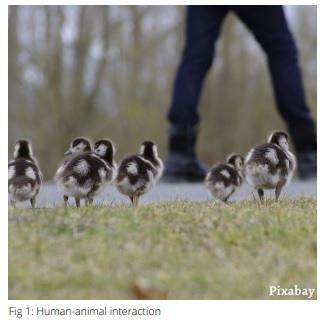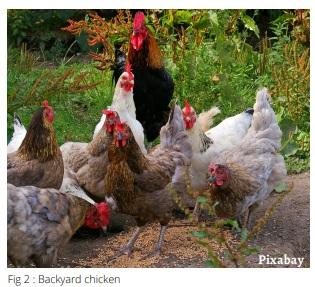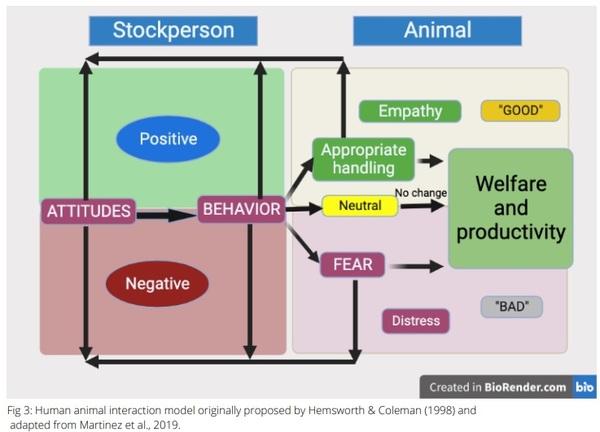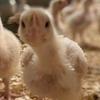Human-Animal Interactions: Impacts on Animal Welfare


- Broilers under chronic stress are known to have decreased weight gain and decreased feed efficiency.
- Laying hens with regular visual contact with humans exhibited reduced avoidance behavior and improved egg production.
- A negative HAI can reduce reproduction in some animals. For example, unpleasant handling of pigs can lead to lower pregnancy rates in sows and reduced testicle size and delayed mating responses in males.
- Negative handling impairs the immune response through production of immunosuppressive hormones such as catecholamines and corticosterone.
- A lower antibody response to Newcastle disease was reported in broilers without any provision of visual contact with humans compared to broilers provided with visual human contact from an early age indicating a poor immune response in the former.


- Fear response - Poultry can become less fearful towards human with gentle handling on a regular basis.
- Production performance - Improvement in body weight gain and feed efficiency.
- Immunity - Increased immune response against viral disease in broilers provided with regular visual human contact.
- Public health - Frequent positive interactions with backyard chickens was associated with low Salmonella prevalence in those flocks. However, a direct cause-effect relationship has not been established.
- Human-animal interactions can be positive, negative, or neutral based on animal's experience.
- Negative HAI induces fear and stress in animals which can adversely affect their health, reproduction, productivity, and welfare.
- Attitude and behavior of stockperson towards proper animal handling can be achieved through cognitive behavioral training.
Acharya, R. Y., Hemsworth, P. H., Coleman, G. J., & Kinder, J. E. (2022). The Animal-Human Interface in Farm Animal Production: Animal Fear, Stress, Reproduction and Welfare. Animals, 12(4), Article 4. https://doi.org/10.3390/ani12040487
Barnett, J. L., Hemsworth, P. H., Hennessy, D. P., McCallum, T. H., & Newman, E. A. (1994). The effects of modifying the amount of human contact on behavioural, physiological and production responses of laying hens. Applied Animal Behaviour Science, 41(1), 87–100. https://doi.org/10.1016/0168-1591(94)90054-X
de Azevedo, C. S., & Young, R. J. (2021). Animal Personality and Conservation: Basics for Inspiring New Research. Animals, 11(4), Article 4. https://doi.org/10.3390/ani11041019
Hemsworth, P. H. (2003). Human–animal interactions in livestock production. Applied Animal Behaviour Science, 81(3), 185–198. https://doi.org/10.1016/S0168-1591(02)00280-0
Hemsworth, P. H., Coleman, G. J., Barnett, J. L., & Jones, R. B. (1994). Behavioural responses to humans and the productivity of commercial broiler chickens. Applied Animal Behaviour Science, 41(1), 101–114. https://doi.org/10.1016/0168-1591(94)90055-8
Martinez, G., Suarez, V., & Ghezzi, M. (2019). Influence of the Human-Animal Relationship on Productivity and Animal Welfare in Dairy Farms. https://juniperpublishers.com/jdvs/JDVS.MS.ID.555825.php
McDonagh, A., Leibler, J. H., Mukherjee, J., Thachil, A., Goodman, L. B., Riekofski, C., Nee, A., Smyth, K., Forrester, J., & Rosenbaum, M. H. (2019). Frequent human-poultry interactions and low prevalence of Salmonella in backyard chicken flocks in Massachusetts. Zoonoses Public Health. 66(1), 92-100. doi: 10.1111/zph.12538.
Mota-Rojas, D., Broom, D. M., Orihuela, A., & Velarde, A. (2020). Effects of human-animal relationship on animal productivity and welfare. Periodikos. http://www.jabbnet.com/article/doi/10.31893/jabb.20026
Rault, J.-L., Waiblinger, S., Boivin, X., & Hemsworth, P. (2020). The Power of a Positive Human–Animal Relationship for Animal Welfare. Frontiers in Veterinary Science, 7. https://www.frontiersin.org/articles/10.3389/fvets.2020.590867
Tallet, C., Brajon, S., Devillers, N., & Lensink, J. (2017). Pig-human interactions: Creating a positive perception of humans to ensure pig welfare.
Waiblinger, S., Boivin, X., Pedersen, V., Tosi, M.-V., Janczak, A. M., Visser, E. K., & Jones, R. B. (2006). Assessing the human–animal relationship in farmed species: A critical review. Applied Animal Behaviour Science, 101(3), 185–242. https://doi.org/10.1016/j.applanim.2006.02.001
Zulkifli, I. (2013). Review of human-animal interactions and their impact on animal productivity and welfare. Journal of Animal Science and Biotechnology, 4(1), 25. https://doi.org/10.1186/2049-1891-4-25
Zulkifli, I., Gilbert, J., Liew, P. K., & Ginsos, J. (2002). The effects of regular visual contact with human beings on fear, stress, antibody and growth responses in broiler chickens. Applied Animal Behaviour Science, 79(2), 103–112. https://doi.org/10.1016/S0168-1591(02)00135-1













.jpg&w=3840&q=75)